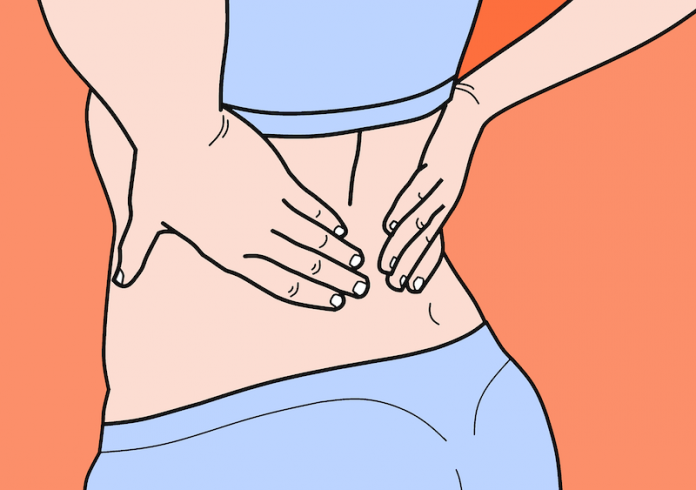
While sciatica is one of the most common forms of back pain, people often assume they have it when they don’t, says U of A physical therapy researcher Greg Kawchuk.
That’s because the condition—named for the sciatic nerve running down the spine and through the leg—is a general term for many different situations.
It can come on suddenly in an acute, disabling way, resolving after a couple of months, or it can fluctuate over time, he said.
Since the pain tends to radiate, it can be felt in a number of places, from the lower back to the buttocks, groin and down the back or front of the leg.
It usually results from compression of the nerve roots as they exit the spine, which is caused when jelly-like cushions between vertebrae herniate, said Kawchuk.
“Sometimes the jelly comes out and it will either push on the nerve root or create inflammation that bothers the nerve.
What’s nice is that we know that in the majority of patients, it usually resolves and goes away over time—just not that quickly.”
It’s also possible to have sciatica without back pain, he said, just as it is possible to have symptoms of sciatica without involvement of the back.
“There are all sorts of other reasons you can have pain down the leg,” he said. “But in sciatica, there is typically pain, numbness or tingling down one leg, and these symptoms are typically worse than any back pain.
Most often these leg symptoms go down the back of the leg, past the knee and into the foot, although there are different flavors of this situation.”
About 85 percent of the population will suffer from back pain at some point in their life, but only between two and 10 percent will have true sciatica, said Edmonton chiropractor James Lemieux, who is pursuing a master’s degree in rehabilitation medicine under Kawchuk.
If the pain doesn’t go away after about three months, and symptoms seem to mimic those of sciatica, you might have pain from other causes, said Lemieux, such as hip-joint arthritis or muscle-referral pain.
Despite potentially aggravating pain, true sciatica doesn’t have to result from severe trauma, he said.
“Sometimes just sneezing or a good cough will bring it on. But typically it’s a result of herniation from age-related changes in the spine.”
Kawchuk had a bad case of sciatica last winter—so debilitating he was literally forced to his hands and knees.
“I couldn’t even sit, and it was three months before I could put my shoes on,” he said.
When severe sciatica does strike, he recommends starting with conservative care.
Pain medications should be resisted or only used for very short periods at very low doses. Many medications, such as opioids, show little evidence of effect.
Even the rush towards imaging such as X-rays and MRIs is not recommended, he said, because they often don’t reveal the source of the problem.
“We know you don’t need to image the hell out of these things. In fact, it probably sets up a lot of poor behaviors on the part of patients. You expect to find the thing and get rid of it, and most often that’s not the way it is.”
If there is pain or numbness in the groin or “saddle area,” and particularly if there is dysfunction of urination or bowel control, you should go see a doctor right away, he said.
“But for the most part, we know that the condition is one that usually clears up with non-surgical conservative care.” If the problem persists after 12 weeks, imaging may be appropriate, he added.
Effective treatments
When sciatica is more persistent, the best plan of attack is a targeted exercise and education program.
“When it’s acute, some short-term pain relief can help, but once things kind of stabilize we know that specific exercise programs designed for these conditions are really helpful. We’ve got strong evidence for that.”
There are two programs that may be helpful for sciatica when the condition calms down and is less acute—a “boot camp for sciatica” developed at the University of Toronto by Carlo Ammendolia, and a therapy originating in Denmark for osteoarthritis in the hip and knee called GLA:D Canada. Both are now highly respected and spreading widely, said Kawchuk.
“The boot camp is a tough program, but the results are phenomenal,” he said.
“It basically involves getting fit in the right areas at the right time. It’s not a magic silver bullet that affects 100 percent of patients, but a good majority say they don’t have to use drugs anymore.”
The “secret sauce” in the programs isn’t in either the exercises or education in isolation, he said. “It’s the fact that someone has bundled it up and said, “Here you go, do it this way.'”
Lemieux, whose master’s research focuses on the GLA:D program, recommends starting an exercise program once the worst of the pain recedes and staying on it even if the condition appears to clear up.
“A lot of people want to rest, and they develop what’s called avoidance behavior, fearing that movement will make the pain worse,” he said.
“You want to get them on an exercise program so they don’t create long-term problems like time lost at work on disability.”
For some, the pain of sciatica may never go away completely, which is sometimes hard for people to accept, said Kawchuk.
In that case, a more realistic goal is to improve quality of life by retaining mobility and remaining active.
“There may be 15 possible causes of your back pain—which one is yours? Until we can figure that out, how do we make people’s lives better? We can’t wait for science to figure out the cure.
“We hope to find the cure, but in the meantime, these are pretty good solutions.”
Written by Geoff McMaster.



